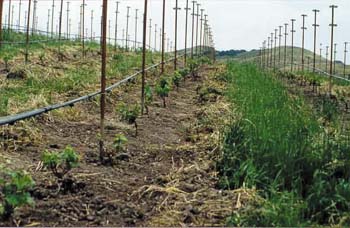First Year Vineyard Care (WineMaker)

Planting a vineyard takes time, effort and planning. But your work is not over once the vines are in the ground. In order to have usable grapes by your third year, you’ll need to carefully manage the growth of your vines.
Goals for the First Year
The first year of vine growth is meant to establish a strong and vigorous root system and build stores of nutrients to hasten growth in subsequent years. The first year of vine growth is not meant to produce fruit for winemaking. During the first year, all clusters should be removed immediately from the vine to keep the vine from using nutrients to ripen grapes. Also, the first year is not meant to push the vine into making fruit or fruiting wood in the second year, when it might not yet be ready to produce clusters. Some vines may be ready to produce fruit in the second year; others may not. The key here is patience and knowing when a vine has established itself to the point at which it is ready to make fruit for wine. In general, a vine is allowed to establish itself and grow vegetatively — producing no fruit — for the first two years in the ground. After the second full year of growth, the vine is commonly pruned by leaving a few canes on the trellis wires. These canes grow fruit in the third year.
Strong Roots
Our first goal is establishing a vigorous root system. In order to do that, the grape grower needs to water the vines, control weeds and control pests. Our second goal is to build stores of nutrients. To do that, the grape grower needs to apply the right type and amount of fertilizers to the vineyard.
Watering the Vines
As soil types and weather are different from location to location, prescribing a watering plan for all growers is difficult. The key here is providing moisture to the vines’ root system without making the soil overly muddy. Allow the roots to dry out between water applications. This will promote root growth as the vines sink their root systems deeper into the soil layers in an attempt to find water. Vines that are “trained” to learn that their water only comes from one place (a drip emitter or a hose) will develop a root ball near the surface of the soil and will not develop a deep and wide root system. Deep, infrequent applications of water are, in my estimation, best for the vine. The vines “learn” that growing deeper in the soil profile helps them find water when the top of the soil is drying out. Here’s a pro tip for assessing a vine’s water status: If the tendril of a vine shoot (there are usually two growing out from near the tip of the shoot) extends further than the shoot’s growing tip, the vine has all the water it needs. When the tendrils shrink back behind the growing tip, the vine is experiencing some form of water-deficit stress. Cut back the water in August or early September to help the vine go dormant (and help the shoot become a mature, wooden “cane”) before the first fall frost.
Weed control
Weed control is absolutely vital in the vines’ early years. Once the vineyard is well established, and the vines have deep root systems, weed control will not be as critical. But, while the vines are young and their root systems shallow, they will be in direct competition with weeds for sunlight, water and nutrients. As a farmer with a strong bent toward sustainable, organic practices, I do not recommend using contact or residual herbicides in a vineyard. It is certainly easier to lay a strip of Round-up through your vineyard instead of hoeing it. Your vines will be safer and healthier, however, if you take the time to be a farmer instead of a chemical applicator.
Run a mower through the center of your rows, making a nice mulch that will feed the soil, and pay a neighbor kid to hoe the rows around the vines. Also learn that planting a cover crop rich in vetches, clover, legumes or other nitrogen-fixing plants can choke out competing weeds and add vital nutrients to your soil. Learn which plants in your area are beneficial and which are noxious. Hoe the bad and leave the good, but make sure to clean out a strip of soil around and under the vine so it doesn’t have to compete for sunlight, water, or nutrients where it is planted and establishing itself.
Giving the vine freedom from weeds will help the roots grow faster, which in turn will give the root hairs more contact with the soil and the nutrients it contains.
Controlling pests
Controlling pests, especially ones that snack on roots, is vital for the health of young vines. Fighting gophers is an ongoing battle in many viticultural regions, and — like Bill Murray in the movie “Caddyshack’” — you may well have to join the fight to assure your vineyard survives. A vineyard is like a neatly ordered smorgasbord for a gopher. They can follow the vine row over a few weeks or months and snack on each vine in turn. All they need to do is chew around the root collar and it’s “game over” for that vine. If you see a dead vine in your vineyard, tug on it a bit. If it comes up easily with a diagonal, slightly-chewed end with no roots on it, you’ve been hit by gophers.
Gophers can be trapped quite easily. Or you can build a few owl-boxes in trees around your property. You will be amazed how many rodents these birds take per night. Poisoning is another option, but you need to be careful of secondary kill of household pets or other beneficial animals.
Deer, rabbits and ground squirrels can also nibble young growth in a vineyard. Fences, bait traps, dogs or a hunting permit may help with these problems. It is common to use a cut-off half-gallon paper milk carton around each young vine to keep rabbits and squirrels from nibbling young shoots.
* A percentage of WineMaker’s content is behind a paywall. If you are new to viticulture and/or winemaking, having a subscription for less than $50 annually is paramount. The resources WM provides are unparalleled, providing workshops, conferences, and online archival access to articles.
All geared to the hobbyist!


